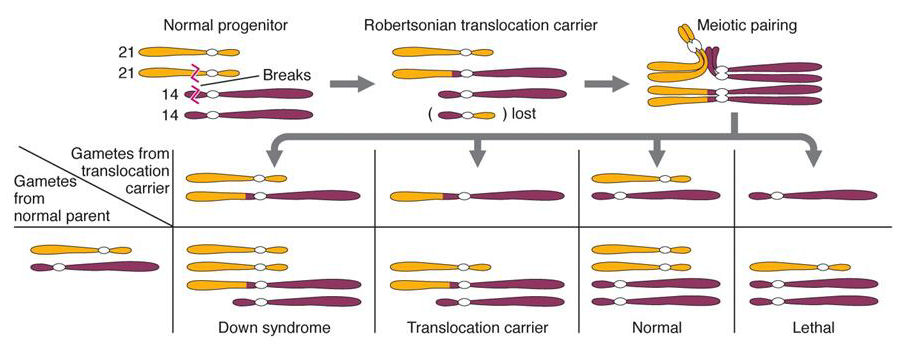
Translocation trisomy in heritable Down Syndrome
Children with Down Syndrome are
typically born to asymptomatic parents as a result of
difficulties that arise during meiosis. Persons with Down Syndrome are
rarely fertile, and so do not pass the extra Chromosome 21 on to
offspring. Thus, although Down Syndrome is "genetic", it is not
typically "heritable"
between generations like Huntington Disease.
Some forms
of Down Syndrome are however heritable, as shown above. In
the germline of an asymptomatic individual, reciprocal translocation
between the long arms of Chromosomes
14 & 21 results in gametes that carry a large
portion of Chromosome 21
on a Chromosome 14
centromere. In combination with a standard gamete from the
other parent, this result is a 2n=46 karyotype with a segmental
aneuploidy for Chromosome
21, producing Down
Syndrome. The karyotype is formally described as 2n = 46, t(14q21q).
Unlike standard Trisomy-21, the translocated chromosome may be passed to an asymptomatic child (the gene locus set is substantially complete) and transmitted to the next generation. In rare cases, a 2n=46,t(q21q21) translocation attaches two Chromosome 21 long arms to a single centromere. All of the children conceived by such a one will then have three copies Chromosome 21, and therefore Down Syndrome.
It is therefore important that all children with Down Syndrome be tested for the exact nature of their chromosomal pattern.
Unlike standard Trisomy-21, the translocated chromosome may be passed to an asymptomatic child (the gene locus set is substantially complete) and transmitted to the next generation. In rare cases, a 2n=46,t(q21q21) translocation attaches two Chromosome 21 long arms to a single centromere. All of the children conceived by such a one will then have three copies Chromosome 21, and therefore Down Syndrome.
It is therefore important that all children with Down Syndrome be tested for the exact nature of their chromosomal pattern.